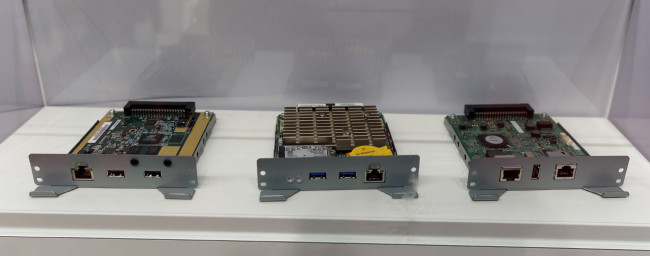Sharp’s new concentration on displays since the acquisition by Foxconn (most of the business in Europe is currently in printing) was obvious at ISE, where the company had a bigger presentation and with six new product ranges, which seems to indicate an acceleration in the development of new products. The aim is to have a full range of products and re-position the brand away from being a specialist with a number of niches to being a ‘full range vendor’.
On the front of the booth was a new frame sequential transparent LCD (FSD), although there were few details available. If LCD response time is fast enough, you can design an LCD without a colour filter and with fewer pixels as each can serve to support separate colours. In fact, the efficiency can be improved by also using white to boost output. The 17″ panel on display was running at 240Hz and was designed as a transparent unit. In our views, for transparent LCDs to be successful, they really have to lose the colour filters, so FSD is a good way to go.
Sharp’s Transparent LCD uses a 240Hz frame sequential technology. Image:Meko
We first looked at a new Interactive touch display that uses direct bonding to give high image quality and minimise issues of parallax. The next product we looked at was the Big Pad PN-40TC1, a 40″ display with a mini-OPS slot and using PCap touch technology. The firm claims that the surface of the display has been treated to give a ‘Pen-on-paper’ experience. Sharp is also starting to get its smart signage technology sorted out and is developing an ‘open Android platform’. It currently has four partners but is looking to develop that. The company told us that its integrated processor is significantly more powerful than the SoCs in the displays of other smart signage. It also has a new USB-based media player so that systems can be set up to run locally if a network connection is lost.
Sharp was showing three mini OPS modules that it has developed and which can be used in its refreshed PN-R range of displays (32″ to 70″, 24/7 and with 700 cd/m²). As far as we are aware, these are the first modules which have been developed for the Mini-OPS architecture which Sharp announced with Intel almost a year ago. We have heard feedback from other vendors that they would have liked a slimmer module design. Although power budgets are smaller on mini-OPS, which could be an advantage as it can mean that the modules can be passively cooled, the real desire is for slimmer units, but that isn’t possible with Mini-OPS. The three modules are a PC, a wireless collaboration module and an HDBaseT interface.
 Sharp showed the first three Mini OPS Modules. Image:Meko
Sharp showed the first three Mini OPS Modules. Image:Meko
The PNQ range is in 60″, 70″, 80″ and 90″ and is (relatively) an entry-level range with 350 cd/m² of brightness with 16/7 duty cycle.
While most video wall displays are 55″, with some in the range between 46″ and 49″, Sharp has introduced a 70″ FullHD video wall monitor, the PN-V701. Sharp pointed out that compared to 55″ displays, fewer are needed. For example, only nine PN-V701 are needed to make a 209″ video wall, while 16 55″ would be need to make a display of 219″. The monitors use Sharp’s own UV2A panels for high contrast and the monitors support Sharp’s UCCT (Uniform Colour Calibration Technology) which makes calibration easier. (Sharp Explains B2B Display Push) The control of colour uses L*LAB for more precise matching to human vision. Staff told us that, out of the box, the displays have a very low level of delta-E error. A special calibration sensor is used (unlike, for example, the Panasonic system that uses an SLR).
Analyst Comment
It’s interesting that Sharp’s 70″ LCD video wall is only FullHD. Although this makes sense from the point of view of typical applications, the pitch of 0.8mm puts the display at about the same resolution at the high end of the LED business (although the cost of the LCD, even at Sharp’s prices, is likely to be a lot less than LED, at least for the moment). (BR)

